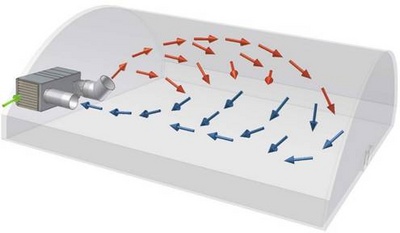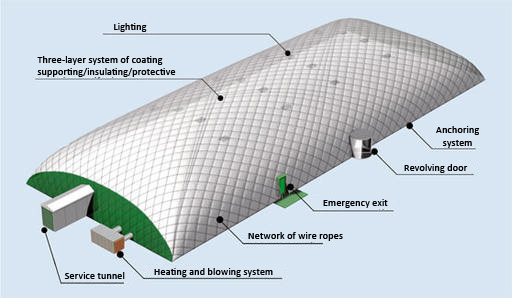Contruction and equipment
of an air domes in GRIMAR system
Shell and lines
The air domes are commonly called balloons.
The installation of an air dome is the cheapest way to cover seasonally a tennis court a football field. The seasonal assembly / disassembly takes only one day and once the hall is disassembled, the courts can be used as an open facility.
The external shell of an air dome is formed by the system of three layers enforced with the steel cable mesh. Each layer has a different function.
As the support layer is used the PVC membrane made of a high-quality nonwoven fabric, covered with elastic PVC on both sides and protected with an acrylic varnish. We use materials with the weight of 620-730 g/m².
The support layer has:
- high breaking strength (the weight of 2,7 tons can be hung on a 5 cm strip of material)
- UV stabilisers which extend durability of materials, protect them against ageing and colour fading
- non-flammability certificate according to the standards: PN-EN ISO 6940 and PN-EN ISO 6941
- resistance against microbial and fungal attacks
- transmission of the sunlight (15%), which ensures a uniform distribution of the daylight inside the hall all day long and eliminates the necessity of any artificial lighting
- possibility of use of colour screens (blends) – contrasting background to improve the visibility of the ball
- possibility of suspension of lighting and separating nets to the supporting shell
The insulation layer is made of a thick bubble wrap. Layered construction of the film and closed air bubbles increase the thermal insulation of the hall and reduce the effect of condensation of water vapour on internal side of the shell. The thermal conductivity of Grimar’s halls is about 2,5 W/m²K.
The outer protecting layer protects two other layers against dirt, snow, wind, soil and UV radiation. As well as the insulation layer, the protecting layer is absolutely transparent and it does not have any impact on the esthetic values of the hall. In Grimar’s air domes we use replaceable protective foils – if the outer layer (foil) is replaced every 2-3 seasons, the hall will always look like new.
The network of wire ropes (steel cables mesh) is designed for every hall individually. The ropes gives the hall a characteristic dome shape. The network enforces the entire construction and the cross connections between the ropes ensure stability of the covering even if the wind is extremely strong.
The net absorbs the loads exerted by the internal pressure and those caused by wind and it transfers them to the anchoring system.
- galvanized or PVC-coated ropes
- the quick anchoring system in the foundations
- the convex coating reduces the echo effect inside the hall
Doors and locks
In the main entrance of every hall there is a three- or four-wing revolving door with the sealing. The revolving door system ensures a high airtightness and prevents the escape of heated air from the inside of the hall. There are often used tunnels in the area between the hall and the auxiliary rooms (cloakroom).
Due to the requirements of the Construction Law and fire safety regulations every hall has an emergency exit. Single-wing door is built in the support layer of the coating. The emergency exit may also be used for a transport of light equipment (wheel-barrow/scaffolding/roller).
Transport locks are used in exceptional situations – in case of surfaces which require the use of heavy equipment, e.g. for rinks or fields of large area.
Forced draught heater
The purpose of the forced draught heater is to maintain an appropriate pressure and temperature inside the hall. The air from the fan passes through the heating system and is pumped into the hall. Part of the air from the hall is returned to the heater and there it’s mixed with the air from the outside. As a result we obtain a continuous circulation of the air and a constant temperature in the entire air dome. The control of temperature and pressure is fully automated.

In case of a blackout or puncturing of the hall, it’ll be automatically activated an emergency system, based on independent Diesel engines which maintain appropriate pressure inside the hall. There is no necessity to use any additional current-generating units.
We provide with an air dome:
- heat exchanger of high-quality steel
- natural gas or fuel oil burner
- double-shell chimney stack made of acid-proof steel
- elastic and insulated airflow ducts (blow-in duct + circulation duct)
- distribution and control box with the electrical protection system and automatic control
… and as an option:
- wind and snow sensor, smooth blow-in regulation
- water heat exchanger, possibility of heating of the hall from the district heating
Lighting
The lamps are suspended from the supporting shell. They are mounted on elastic hangers. The electric cables and hangers can be installed very quickly and easily. Depending on the purpose of the air dome we use the following lamps:
- LED – modern, energy-saving and efficient lighting system offered as standard. A wide range of luminaires, power and color of light makes that we can adapt them to any use. For an investor or user that means a few times less electricity consumption compared to conventional luminaires.
- fluorescent lamps – waterproof, energy-saving lamps; as a standard for the illumination of tennis courts we use 30 lamps, everyone with a 58 W double power source; they ensure excellent light dispersion
- metal-halide lamps – the use of lamps with a symmetric and asymmetric reflection allows to achieve a uniform light intensity; these lamps are made of toughened glass and they are durable and resistant against impacts: depending on the project we use 400 W or 2000 W lighting elements
We always provide with the lighting system a remote control panel as well as an electrical protection system. The control system allows to control the lighting in the selected part of the hall.
As an option:
- remote control
- time control
- external illumination
Anchoring system
The forces caused by the internal pressure and by wind gusts require an appropriate anchoring system. In the contrary to the typical foundations, the anchoring system in an air dome is designed taking into consideration the extraction forces. The anchoring is made along the entire circumference of the hall, usually at regular, 3,0 m intervals.
The halls manufactured by Grimar are anchored using the network of wire ropes. The PVC coating freely rests on the floor and the sealing is ensured by rolling the excess of material.
The anchoring is made using of the following technologies:
- concrete ballasts, buried in the soil or embedded in the concrete
- piling – setting of steel profiles in the ground with the use of a vibration technology

